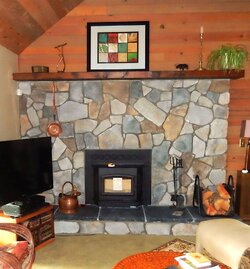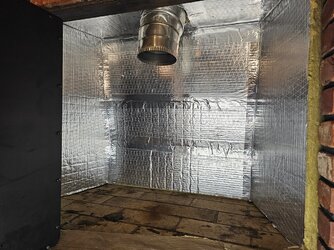Thanks to help from this forum in my decision making, I finally finished having my Buck Stove 81 installed as an insert in my very large fireplace. I'm attaching a picture so, if you were involved in that discussion you can see the end result (pre-fire). It's hard to tell, but the front projects about 7" into the room so heat radiates from the sides, too. Looks great! Overall, I'm a happy camper.
It's working great today, 45 degrees and no wind, so my house is toasty. But two weeks ago it was 13 degrees and 50 mph wind at my house. Not the norm, but the reason I made the change to an insert in the first place. I'm suspicious that the insert wouldn't have been able to handle it because....
The fireplace the stove is sitting in is a steel box 40"h x 50"w x 30" deep, and the chimney flue is 24" x 24" (yes, 4 sq ft!) ceramic in a 20' tall brick chimney. I understand the original flue area surrounding the new insert's 6" diameter flue is capped up top, but that 6" flue travels up through the original damper of the huge fireplace flue, so the steel fireplace space is basically open to the elements, and heat rises. It takes 15-20 minutes for a strong fire to heat up that fireplace & chimney space. I have a hard time imaging that a huge percentage of the heat generated by this big stove isn't just going up the chimney on a regular basis, as before.
Am I misunderstanding how this works, or is there something I can do to make it more efficient? Can you insulate the some part of the original flue space (maybe at the top?) or somehow close down the unused original damper space? Or is it just what it is? I know I'd have this concern with whatever I had installed, but would welcome suggestions.
Thanks.
--L.

It's working great today, 45 degrees and no wind, so my house is toasty. But two weeks ago it was 13 degrees and 50 mph wind at my house. Not the norm, but the reason I made the change to an insert in the first place. I'm suspicious that the insert wouldn't have been able to handle it because....
The fireplace the stove is sitting in is a steel box 40"h x 50"w x 30" deep, and the chimney flue is 24" x 24" (yes, 4 sq ft!) ceramic in a 20' tall brick chimney. I understand the original flue area surrounding the new insert's 6" diameter flue is capped up top, but that 6" flue travels up through the original damper of the huge fireplace flue, so the steel fireplace space is basically open to the elements, and heat rises. It takes 15-20 minutes for a strong fire to heat up that fireplace & chimney space. I have a hard time imaging that a huge percentage of the heat generated by this big stove isn't just going up the chimney on a regular basis, as before.
Am I misunderstanding how this works, or is there something I can do to make it more efficient? Can you insulate the some part of the original flue space (maybe at the top?) or somehow close down the unused original damper space? Or is it just what it is? I know I'd have this concern with whatever I had installed, but would welcome suggestions.
Thanks.
--L.



